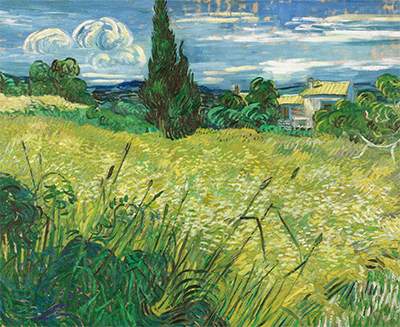Vincent van Gogh’s ‘Green Wheat Field with Cypress’ is a vibrant oil painting that the artist completed in 1889, a year during which the artist voluntarily incarcerated himself at Saint-Paul-de-Mausole, a hospital for the mentally ill situated near Saint-Rémy in Provence.
The year that Vincent spent in the hospital was particularly productive. He was given room inside the clinic to use as a studio and he would also often be seen sitting by his easel, painting in the walled garden. During the course of the year he reputedly painted over 150 pieces. Notable among the many of his works completed over the period, was the iconic ‘The Starry Night’ which depicted the view from the east-facing room in his asylum with the addition of an imaginary village.
Later the same year he also completed the last and most famous of over 30 self-portraits, a striking work which is now one of the most recognised paintings in Western art.
As part of his rehabilitation, the doctors at Saint-Paul allowed the artist to take regular walks outside the main grounds of the hospital. He was inspired by the landscape and began to paint pictures of the local olive groves, wheat fields and purple lavenders. He was particularly interested in the cypress trees and he would paint them again and again – their bows and branches writhing through the air like ebony flames.
‘Green Wheat Field with Cypress’ is, perhaps the most accomplished of these landscape paintings. Like much of the artist’s work at the time it was painted in oil on a size 30 canvas measuring 73 x 93.5cm. It depicts a swirling, uneven wheat field, the green ears of the harvest beginning to meld themselves into the amber hues of the season.
A cypress tree stands gaunt against the horizon, a dark and imposing obelisk stretching up towards the eddying clouds above. A pretty, yellow roofed house sits behind the field, its clean lines and solid structure impervious to the churning natural world seething around its walls. The azure Provencal sky watches on, a dispassionate ribbon of blue and, in the foreground, the stygian shadows of the hedgerow’s many brambles wrestle themselves onto the canvas.
Van Gogh once wrote in a letter to his brother Theo that ‘painters being dead and buried speak to several following generations through their work’. The multiple works of Van Gogh provided a huge amount of inspiration for many artists that came after him, Henri Matisse and Paul Klee being amongst the first to be inspired by Vincent’s masterful technique.




